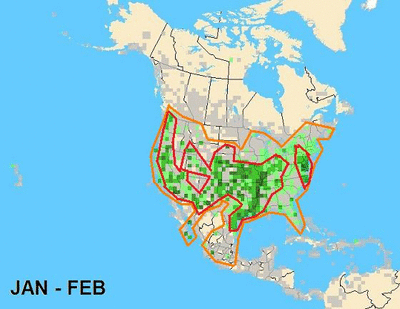This time of year (March through April), there are tens of thousands of
Snow Geese moving through an area about 50 miles west of where I live at
Fort Boise Wildlife Management Area. We see this major bird event every spring, but in the fall, we hardly see any Snow Geese. The first Snow Goose I ever saw was around Thanksgiving time in Scottsdale, AZ. This got me to wondering...which route(s) do Snow Geese take in the fall to head for warmer climes? I pulled together these eBird sightings maps, which range maps are only as comprehensive as there are eBirders submitting checklists across North America. We have enough data from 2003 through today in 2010 that we can detect some patterns. I added an orange border line to indicate general range during that month and a red border line to emphasize higher frequency reports, most likely revealing higher population densities of Snow Geese during that month.

Gif maker
The winter range of the Snow Geese appears to be a swath from the Pacific Northwest, down through California, across the Southwest, Texas and lower mid-west, almost avoids the southern states and concludes around the eastern Great Lakes and eastern seaboard.
In March, the Snow Geese begin to move north, and one route seems to take them right along the Idaho-Oregon border where I have been able to observe the awe-inspiring event. They appear to also move up through the mid-west in a large swath somewhat centered on the Mississippi River. Another route northward appears to exist in the states that lay between the Great Lakes and the Atlantic Ocean.
In April they expand into the lower provinces of Canada, but along the Pacific Coast they make it all the way into Alaska. By May, the higher concentrations of Snow Geese are in the mid-western states, most of Canada - from Hudson Bay west, and well into Alaska. There is also a dense cluster in Quebec.
By June the Snow Geese are enjoying the cool summer weather at the Arctic Circle where they are known to breed on the tundra. The goslings don't have long to grow-up and join their parents on the flight southward as the maps shows July and August concentrations of Snow Geese in the Great Plains again.
The autumn months of September, October, and November show the Snow Geese expanding from the midwest into the warmer southern states for their wintering grounds. So, in answer to my initial question, why do I see Snow Geese in the spring, but not in the fall...we see that the majority of the Snow Geese are migrating through the midwest and then spreading out in the southern region. While they appear to have three routes heading north, the have one main route heading south.
Yet, that secondary population in Quebec down through region including New York, Pennsylvania, and New Jersey strikes my curiosity. They appear to be in that area nearly year round with just a slight movement north and south. Can anyone from that area confirm what the maps seem to be telling me?
For more about Snow Geese, check them out at AllAboutBirds.com. It is also interesting to compare field guide maps to those generated by eBird users like you!


I guess you read my favourite book "The Snow Geese" by William Fiennes?. Your picture reminded me.
ReplyDeletePhil - AnotherBirdBlog
Yet, that secondary population in Quebec down through region including New York, Pennsylvania, and New Jersey strikes my curiosity. They appear to be in that area nearly year round with just a slight movement north and south. Can anyone from that area confirm what the maps seem to be telling me?
ReplyDeleteThose Geese are not snow Geese, rather Canadian Geese that have changed their pattern because of a steady food supply. They no longer migrate. Which makes them the relative that came to visit and never left.
There are ALSO snow geese. I live on Delaware Bay 40 miles north of the Maryland Border. The geese started arriving here in October and I am looking out my window at a flock of 10,000. It has been so unseasonably warm, that they don't need to migrate any farther south.
ReplyDeleteWe didn't see any geese here in Delaware from May when we arrived through September, however.
We have also see flocks of Canadian Geese.
We have a snow goose here in Jacksonville Florida, it is all by itself and doesn't hang around all the Canadian geese that are here, it is honking and seems healthy, I am surprised to see this beautiful creature here, I have never seen one here in N. Florida.
ReplyDeleteMany, many geese are flying north, directly over Butler, PA today and in recent days. I cannot tell if they are Snow Geese or Canadian Geese. It's amazing to see...and hear!
ReplyDeleteI'm in jacksonville beach Florida watching a snow goose feeding. It's all alone and avoiding the Canadian geese
ReplyDeleteWatching one right now in jacksonville beach Florida
ReplyDelete